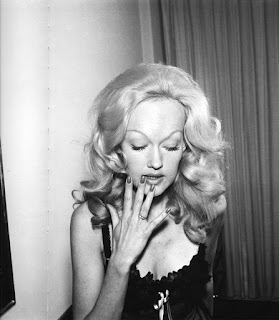PHOTOGRAPHER/EXHIBITION RESEARCH
HE/SHE/THEY
'A GROUP EXHIBITION HIGHLIGHTING OUR COLLECTIVE NOTIONS OF IDENTITY'
 |
| Screen grab from HE/SHE/THEY exhibition website of select photographer's work (rosegallery.net, 2019) |
After deciding to explore gender representations in media as my photographic theme, I wanted to research deeper into photographers that have also played with the boundaries of segregated gender roles.
HE / SHE / THEY collects the
work of various photographers who utilize their own and others’ image to find
what lies beyond the constructs of prescribed gender and sexual identity, ideas that are central to my own photographic project theme. The
exhibition took place at the Rose Gallery in Los Angeles in 2016, with works by
Manuel Álvarez Bravo, Diane Arbus, Nancy Burson, Andrew Bush, Antonio
Caballero, Jo Ann Callis, Graciela Iturbide, Wayne Lawrence, Jocelyn Lee, Nikki
S. Lee, Susan Meiselas, Yasumasa Morimura, Lise Sarfati, Tomoko Sawada and
Katsumi Watanabe (rosegallery.net, 2019).
'Through addressing the
questions of sexuality, gender, personal expression, and identity, these
artists relay the complexities of self-representation. With subjects that
challenge the creation of identities based on gender and idealised norms, the
artists’ works reflect the burgeoning independence from the prescribed norms
of gender and sexuality' (rosegallery.net, 2019).
 |
| Diane Arbus, A Naked Man Being A Woman, NYC, 1968 |
 |
| Diane Arbus, Girl sitting on her bed with her shirt off, NYC, 1968 |
 |
| Katsumi Wantanabe, KW 237, 1968 |
The photographs above show
work of Diane Arbus and Katsumi Watanabe in contribution to this exhibition.
‘Arbus’ documentary work in
New York and Katsumi Watanabe’s portraits in Tokyo both explored the lives of
the ‘other:’ those who live the roles not prescribed to their bodies. Female
impersonators, drag queens and androgynous people strike the eye as the
juxtaposition between the expected and their choice of being defies gender
expectations. Katsumi Watanabe’s photographs of drag queens, prostitutes,
gangsters, and entertainers, created as portraits for the subjects themselves,
are filled with the candid uniqueness of each sitter as they saw themselves,
regardless of gender constructs’ (rosegallery.net, 2019).
The above photograph by
Graciela Iturbide shows Magnolia, who identified as Muxe, Zanoteca for homosexual and gender queer. This
self-expressive portrait confidently challenging gender roles and concepts of masculinity
contrasts with Manuel Alvarez Bravo’s portraits of Salvador Novo and Xavier Villaurrutia,
which exert a masculine, refined image of the Mexican writers. These works show
the difference in conceptions/portrayals of masculinity in American/South American
subjects. Bravo’s work shows a
composition and body language that I am interested in taking inspiration from
for my own photographic work.
 |
| Antonio Cabarello, Jaqueline Voltaire I, 1975 |
 |
| Antonio Cabarello, Ingrid, 1970 |
'As a young man, Antonio
Caballero discovered the fotonovelas,
small comic-book-like graphic novels that were popular throughout Latin
America, Spain and Italy from the 1940s until the 1980s. Creating his own fotonovelas, Caballero photographed and
assembled his own story lines and photographic narratives. These selected
sheets emphasize the distinctly objectified feminine sexuality often seen in
popular media, and without accompanying text the images reveal the power of the
pose in storytelling' (rosegallery.net, 2019).
These photographs highlight sexualisation of women in the media by making the subject, costume and camera angles deliberately sexual, blatantly addressing the issue in plain sight. The power of body language shown in these images is something I wish to use in my own work, allowing the body language of my subject to portray plainly and blatantly the differences in gender representation.
For more detailed information and works from all photographers involved in this exhibition, please visit the gallery's website,
http://www.rosegallery.net/exhibitions/heshethey.
All images accessed from:
Rose Gallery (2019) HE/SHE/THEY. Available at: http://www.rosegallery.net/exhibitions/heshethey (Accessed 03 May 2019).



Comments
Post a Comment